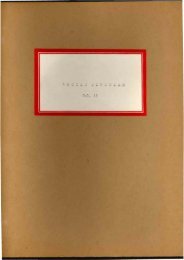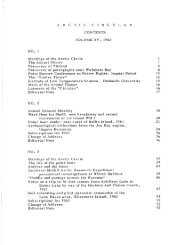Volume 4, 1951 - The Arctic Circle - Home
Volume 4, 1951 - The Arctic Circle - Home
Volume 4, 1951 - The Arctic Circle - Home
You also want an ePaper? Increase the reach of your titles
YUMPU automatically turns print PDFs into web optimized ePapers that Google loves.
Manitoba-Saskatchewan boundary. <strong>The</strong> chief physiographic<br />
feature of southern Manitoba is the Manitoba Escarpment,<br />
the steep eastern slopes of a chain of north-northwesterly<br />
trending hills, of which Pembina Mountains, southwest of<br />
Winnipeg, and the Pasquia Hills of Saskatchewan, west of<br />
<strong>The</strong> Pas, are the terminal ones. <strong>The</strong> low country between<br />
Lake Vfinnipeg and the escarpment is underlain by Ordovician,<br />
Silurian, and Devonian limestones, largely covered with<br />
glacial drift and the deposits of glacial Lake Agassiz.<br />
<strong>The</strong> higher country west of the escarpment, forming the second<br />
major prairie level, lies on shales of Cretaceous age. A<br />
relatively small region of prairie grassland occurs in the<br />
southern part of this level, much of it in the ancient basin<br />
of glacial Lake Souris. <strong>The</strong> prairie district is characterized<br />
by high summer temperatures, warm, dry winds, and a<br />
low rainfall of varying seasonal distribution and fluctuating<br />
widely from year to year. Glacial erosion has removed al~<br />
*~y~ii 9f T~rtiar~ aÔe except on Turtle Mountain, which<br />
straddles the fort1-ninth Daralleln Th~ ùcntinuous forBBt<br />
cover or the upper ~eve~s or this hill may proper~y be considered<br />
a southern outlier of the aspen-parkland, and<br />
indicates a more humid climate than on the adjacent prairie<br />
lowlands.<br />
Tuberculosis Survey: Jame~ and Hudson bays, 1950<br />
ln the summer of 1950 an X-ray survey of the natives<br />
living in the area to be served by the new hospital at Moose<br />
Factory was carried out by the Indian Health Services of the<br />
Department of National Health and Vfelfare. <strong>The</strong> area covered<br />
included the west coast of James Bay and the east coasts of<br />
James and Hudson bays as far north as Cape Smith. Dr. R.N.<br />
Simpson was in charge of the Survey and the party included<br />
Dr. D.S. Davis, dentist, and Mr. K. Wedderspoon, technician.<br />
<strong>The</strong> party arrived at Moosonee on June 12 and, after<br />
having held clinics at Albany~ Attawapiskat, Moose Factory,<br />
and Moosonee proceeded to Rupert House by R.C.M.P. Peterhead<br />
boat. Clinics were held at Rupert House and Nemiscau, which<br />
was reached by aircraft, and the party then went on to<br />
Eastmain. <strong>The</strong>re, as at Rupert House, the natives seemed to<br />
have many minor complaints which were thought to be the<br />
result of poor living conditions prior to the beaver quota.<br />
On the way north the party stoppad at the Cape Hope Islands<br />
and arranged for the Eskimo there to go to Old Factory. At<br />
Old Factory the living conditions of the Eskimo were found<br />
to be poor since they had he.à.2.ittle 0:' no tro.pping. A<br />
beaver quota which has now been arranged shc~ld improve<br />
their economy. At Fort George, the largest settlement in












